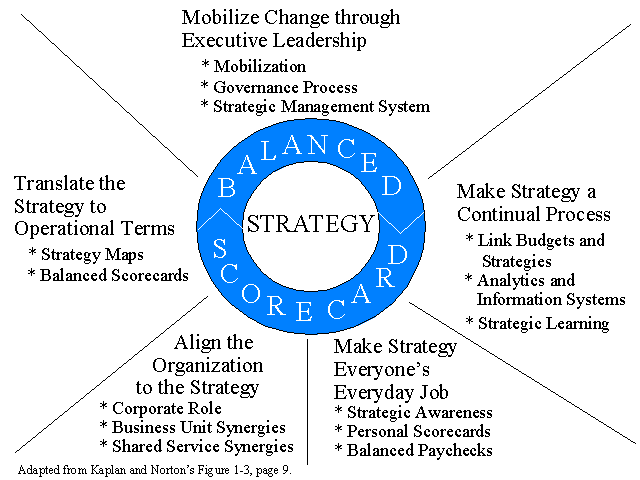
Study Guide by Abby Farrell
Bachelor of Accountancy Program
University of South Florida, Fall 2003
Balanced Scorecard Main Page | Performance
Measures Main Page | Strategy Main Page
Chapter 1: Creating the Strategy-Focused Organization
Organizations today use decentralized business units that focus on intangible knowledge, capabilities, and relationships created by employees. Some organizations understand that strategy must become a continual and participative process. The change from centralized command, and financial measures that come from past actions can no longer measure the objectives that need to be addressed. We must measure the strategy and the best tool to implement such a practice is the balanced scorecard.
The Balanced Scorecard allows organizations to build a management system that manages strategy; a strategy-focused organization. Strategy means communicating in a way that everyone can understand a plan for success. Focused means navigation in the organization to align strategy, and organization means to mobilize all employees to act in different ways that will link together across the business. The Balanced Scorecard provides a framework to look at strategy from four different perspectives; Financial, Customer, Internal Business Processes, and Learning and Growth. It gives managers the accurate information to make important decisions that effect everyone in the company.
There are a handful of examples of organizations that have been successful in using the Balanced Scorecard, such as Mobil North America Marketing and Refining, CIGNA Property & Casualty Insurance, Brown & Root Energy Services, Rockwater Division, and Chemical (Chase) Retail Bank. All of the prior companies mentioned used the five principles of a strategy-focused organization:
1. Translate the strategy to operational terms,
2. Align the organizational strategy,
3. Make strategy everyone's everyday job,
4. Make strategy a continual process, and
5. Mobilize through executive leadership.
These five principles help companies achieve such focus and alignment. The illustration below provides a graphic view of the ideas in this chapter.

A strategy map is a tool for translating strategy into operational terms as indicated in the graphic illustration above. Strategy maps, combined with balanced scorecards, provide a new framework for describing and implementing strategy. Kaplan and Norton define a strategy map as "a logical comprehensive architecture for describing strategy. It provides the foundation for designing a Balanced Scorecard that is the cornerstone of a strategic management system." (p. 10). Several strategy maps are illustrated below.
Chapter 2: How Mobil Became a Strategy-Focused Organization
It all started with a desire for a 5% increase in ROCE (return on capital employed) and a way to plan : normal" productivity and growth. Mobil launched the Balanced Scorecard project in 1994. Bob McCool became CEO of NAM&R (Mobil North America Marketing and Refining) in 1992 and spotted a need for a new strategy that would improve the organization. They exercised the 5 principles of a Strategy-Focused organizations, and even beat the odds in an unfavorable market. They scrutinized the productivity and growth aspects. The productivity theme focused on cost reduction and asset intensity. The growth component focused on volume growth rate versus industry growth rate, and percentage of volume in premium grades.
They examined the customer perspective, dividing the consumers into 5 categories;
Road warriors (higher-income, middle-aged men), which made up 16% of sales,
True Blues (men and women who were loyal to a brand name),
Generation F3 (men and women constantly on the go) at 27%,
Homebodies at 21% (Housewives) and
Price Shoppers (are not loyal; looking for the lowest price) at 20%.
Mobil had to choose whom to cater to. They chose to cater to Road Warriors, True Blues, and Generation F3 to sustain premium prices and commodity products. Mobil identified attributes that should appear at all Mobil stations such as clean bathrooms, safe well-lit stations, and speedy purchases. They decided to have mystery shoppers evaluate the performance being followed by the employees. Mobil also started to focus on independent owners of the gasoline station. Mobil had not considered them as a component of strategy in the past. Mobil now decided to adopt objectives that would be profitable for both Mobil and the franchise operators.
Mobile started to develop win-win relationships with every aspect of the business they were involved in. They developed scorecard-building processes. Even the truck drivers who carried the gas were instructed to drive safer, be reliable, and be a 'good neighbor' (make sure everything in the station is safe). They were warned that mystery shoppers would inspect them as well. Unexpected feedback came from the truck drivers when they started calling with similar experiences, such as this one.
"You had better get someone from region up to this station fast. If a mystery shopper showed up there, the station would flunk and our 'delight the consumer' score would be destroyed. The Mobil sign is broken, half the lights are out, the restrooms are filthy, the convenience store is serving stale doughnuts, and running out of stock, and the employees are yelling at the customers. This is not the new Mobil strategy of 'fast, friendly service.'"
This type of feedback helped the company clean up the areas of Mobil that were struggling with the new and improved concepts.
Another attribute, speedy purchase, caught the attention of a manager by the name of Joe Giordano. He conceptualized a simple device that allowed the customer the pleasure of not having to dig through their wallet or purse trying to find a credit card or cash to pay for gas. This device would attach to the key chain, and is now know as the Speedpass.
With overwhelming success, each employee got to share a $35 million dollar incentive award based on a corporate component, division component, and a business component. Mobil created a win-win situation by incorporating the 5 principles of a strategy-focused organization, and continual implementation of the strategy process. An adaptation of Mobil NAM&R's strategy map appears below.
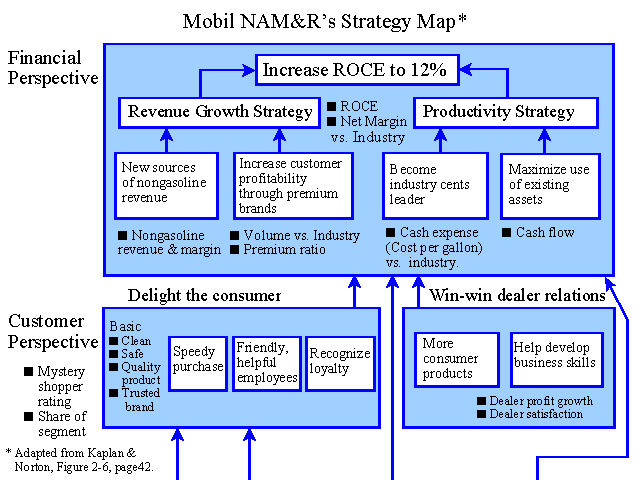

Chapter 3: Building Strategy Maps
"The key for implementing strategy is to have everyone in the organization clearly understand the underlying hypotheses, to align resources with the hypotheses, to test the hypotheses continually, and to adapt as required to real time."
A strategy map makes the outcome more apparent to the users and helps the company build a cause-and-effect perspective. When looking at the financial portion of growth and productivity, it clarifies non-financial measures such as quality, improving the product, and availability. The BSC also improves indirect linkages to intangible assets. Kaplan and Norton continue to discuss the metaphoric recipe of intangible ingredients, such as skill, technology, and the environment internal processes that take place.
A mission is important not only to managers, but to everyone in the organization. Vision and strategy complement each other, but there needs to be a strategy in order for anything to be achieved. The BSC helps keep the organization focused on its strategy in making the vision a reality. These ideas are conveyed in the graphic illustration below.
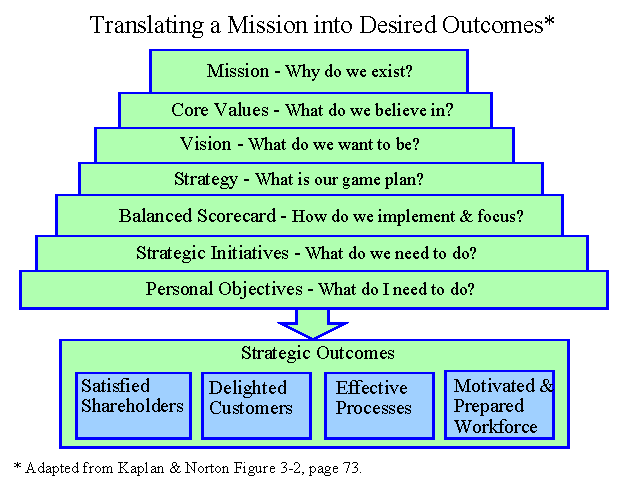
There are four themes to provide a way to segment strategy:
Build the franchise,
Increase customer value,
Achieve operational excellence, and
Be a good corporate citizen.
It helps build long-term (build the franchise), mid-term (increase customer value), and short-term (operational excellence) cause-and-effect relationships. Revenue growth focuses on building strategy and increasing customer value while productivity is composed of improving cost structure and improving asset utilization. Product leadership, customer intimacy, and operational excellence are activities that lead to competitive advantages.
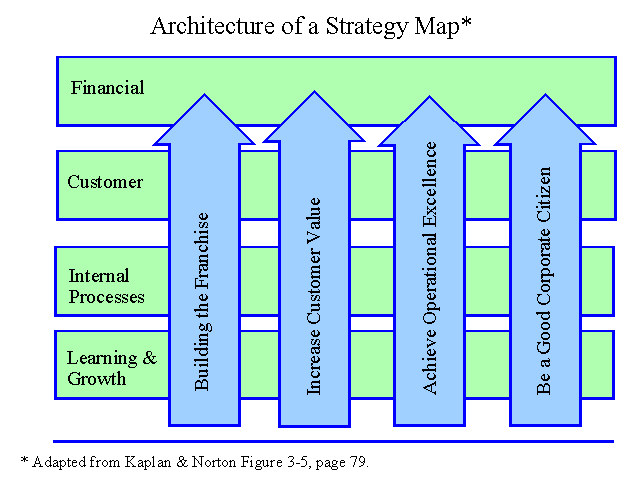
An example of a strategy map that had a vision is Store 24. It caters to teenagers and the store wanted to differentiate themselves from other stores by providing entertaining and unexpected fun during the shopping experience. They ensured this goal by investing in training for staff, and producing innovative new layouts to ban boredom while shopping. They reached their goal by creating a vision and compiling a strategy to achieve uniqueness in their industry. Store 24's strategy map is represented in the graphic illustration below.
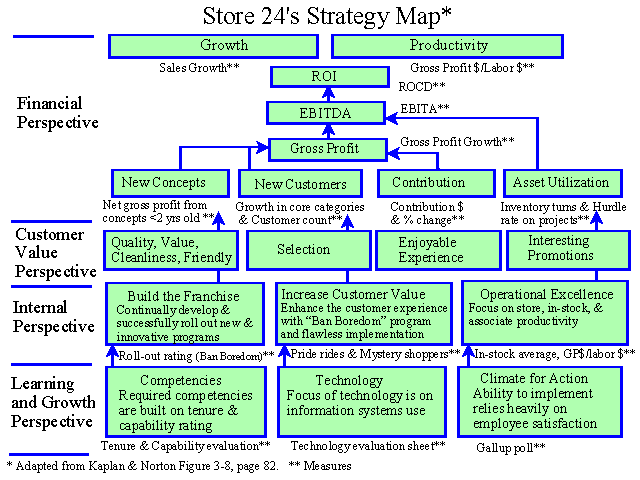
The BSC is a good indicator of success in a company because it identifies, and aligns the components in an organization together. Some strategies such as KPI (key performance indicators) and constituent/stakeholder scorecards may not lead to successful outcomes because they do not reflect the strategy of the organization. You can't look at the scorecard and understand the strategy. BSC helps to adapt vision, strategy, and outcomes so that it is more conceivable to those who have to implement it. This idea is illustrated in the Generic Balanced Scorecard Strategy Map provided below.
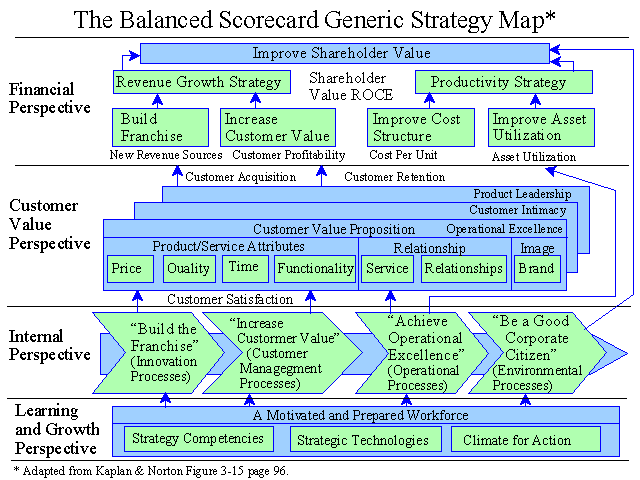
Chapter 4: Building Strategy Maps in Private Sector Companies
This chapter illustrates how the strategy maps discussed in chapter 3 encourage operational excellence. The book gives a few examples of companies that were successful. The National Bank Online Financial Services (OFS) was one of the companies that knew they needed to communicate the strategy of setting goals to customers, managers, and employees, and they needed to focus on their internet service sector. In 1994, they had only 20,000 customers using OFS, and that jumped to 350,000 in just four years. They established a new goal: To reach their millionth customer using OFS by 2000. OFS set three themes:
1. To retain high-valued customers.
2. Increase revenue per customer.
3. Reduce cost per customer.
They focused on differentiating factors including speed, response, security, fair price, and reliability. As they communicated this through the OFS chain, they got feedback from everyone throughout the company, which helped build the Balanced Scorecard objectives. OFS also cross-sold new products through 3rd party alliances via the internet, from flower for Mother's Day, to carpet cleaner.
OFS was curious to see if their themes and goals were being reached. Astonishingly, they reduced their cost by customer. If one were to go into the bank to do a transaction, it would cost National Bank $1.25/transaction, roughly. Online, it only cost .01! Customers liked managing and monitoring their own bank accounts online. Disputed payments dropped by 50% that year. OFS's revenues grew because customers were buying 3rd party items through the website, and, in 1999, OFS celebrated their 1,000,000th customer, along with a series of 'Best Online Bank' awards and recognition.
Other organizations discussed in this chapter include Fannie Mae, Nova Scotia Power, Inc., and AgriChem Manufacturing Industries. The chapter includes some rather involved strategy maps for Nations Bank's online service, Fannie Mae and AgriChem. An adaptation of Fannie Mae's strategy map appears below.
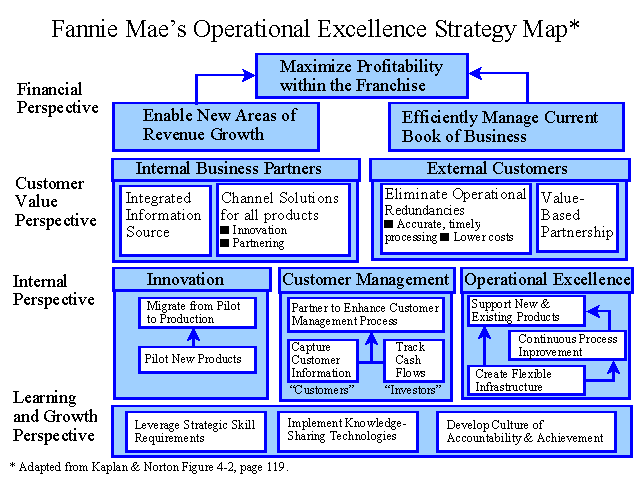
Chapter 5: Strategy Scorecards in Nonprofit, Government, and Health Care Organizations
Nonprofit and government agencies have trouble defining strategy. Using the BSC, they must change their focus from product leadership and customer intimacy to local processes and improvement. Unfortunately, many of these organizations use KPI (key performance indicators) scorecards as a guiding map instead of concentrating on the specific objectives.
These agencies had trouble with what goals to place at the top of their hierarchy. They chose both donor and recipients. The government agencies had 3 objectives; Cost incurred, value created and legitimizing support.
The city of Charlotte focused on a mission. "Community of choice for living, working and leisure activities." They were unsure how to implement the strategy, but they came up with a plan that had 5 themes; Community safety, Transportation, City with in a city, Restructuring government, and Economic development, placing citizens at the top of their BSC (balanced scorecard).
Another example of a government agency is VBA (Veterans Benefit Admin). They also had 5 measures; Customer satisfaction (Veterans), Cost (taxpayer), Speed, Accuracy, and Employee development. Now these government agencies had a way to measure their performance.
DDT (Division in US Department of Transportation) was the first government agency to develop a BSC. They use to compare results with only speed processing but changed their objectives through the BSC and processing times have dropped, and customer satisfaction has increased.
Overall, the BSC helped all these organizations to highlight the importance of human resources mixed with their primary functions. It goes to show that the BSC is not just for companies but can also enhance performance for government agencies as well.
Chapter 6: Creating Business Unit Synergy
Organizations need to determine how to add value to their business so that the whole is greater than the sum of its parts, hence the term, synergy. For example, retailers and wholesalers should prefer to work with only 1 supplier because they receive benefits such as: Discounts in bulk purchases, and special prices and supplier attention.
There were many different case studies of synergy in organizations, and I will explain the case study of Charlotte, NC. The city manager, after developing a BSC (balanced scorecard), asked all the functional operating units to develop individual BSCs. For example, transportation, police stations, community development, etc. had to come up with their own measures of success. The transportation operating division added measures such as, 'availability of safe, convenient transportation' and 'improve service quality.' Such measures were incorporated into the departmental BSC of Charlotte, NC as well.
The police station worked hard on implementing their plans by revoking liquor licenses of alcoholic beverage outlets because of numerous nuisance complains, thus allowing other businesses to operate in the community. This was also a way to mitigate crime.
The city also developed cabinets, which consisted of department heads that could influence the strategic themes. The BSC brought these people together once a month to plan new initiatives to strengthen neighborhoods. For example, an important retailing giant packed up and left a local shopping mall, which raised important questions as to why they left.
BSC's strategy for the customer-based units provide guidance to operating functional units.
Chapter 7: Creating Synergies through Shared Services
Creating a BSC for shared services should align strategy so they add value. They link shared service units with business units. The two models for developing shared serviced are:
The Strategic Partner Model which is a partner to the process
of reflecting the strategy, and
The Business-in-a-Business Model, in which they view other
business units as their customers.
Shared Service units (SSU's) create external value and create a linkage to the Strategic Business Units (SBU's). This requires four components:
1. Service agreement which defines expectations about services and costs.
2. The shared service units scorecard.
3. The linkage scorecard and
4. Customer feedback.
And example that has been used consistently throughout this summary is Mobil North, which undertook this strategy. This two-tiered scorecard helped Mobil establish a clear understanding between the internal customer and service provider. Shell Services International also had a service level agreement that included performance measures such as
1. Customer Satisfaction
2. Quality of support (speed of delivery)
3. Technical end-to-end measurements and
4. Business alignment (ease of doing business.)
This BSC and customer feedback helped to identify processes that needed improvement by lowering costs using new Web-based technology and cross-functional efforts. The BSC allowed joint ventures to create value to a company as well. The BSC for SSU's identified and clarified opportunities for synergy.
Chapter 8: Creating Strategic Awareness
When launching new strategies, the entire company must be involved. Executive and BSC advocates came up with creative ways to achieve this extensive, continuous goal. Companies wanted workers to find new ways to conduct their day-to-day business. In order to translate the idea to reality, they stressed top-down communication and evaluated by results, not activities. 'Just because a message has been sent doesn't mean it's been received.' They decided to reach the masses of employees through awareness by quarterly meetings, brochures, monthly newsletters, education programs, and company intranet. Mobil posted their BSC everywhere on bulletins at every site, had a newsletter, and the president appeared in a 1 hour briefing to the results of the BSC performance, and to respond to questions of the employees. In 1995, only 30 people were aware and showed up. In 1999, over 500 people showed up.
Companies utilize the internet as well. Motorola created a website to spread awareness of their BSC. Sears created a map of the retail company and plotted the successive decades to show how they got to where they are now. Sears became a compelling place to work, shop, and invest.
Strategy trees communicated the messages further by linking the elements of the company. This helped to clarify objectives that contributed to the overall organization and relate the cross-functional relationships. Mobil held meetings and had employees go up to the strategy tree to point out where they were on the tree and how they contributed to the impact of the overall financial assessment, ROCE. Employees and everyone in the organization must understand the measures of the strategy to impact the organization in a positive way.
Chapter 9: Defining Personal and Team Objectives
MBO (Management By Objectives) has become more bureaucratic and burdensome today because it is more of a traditional way to ask people to do their jobs. It reinforces narrow, functional thinking. Another problem is that the Human Resources function does not typically align to strategy. Only 51% of senior managers have personal goals linked to strategy, 21% of middle managers and 7% of employees, respectively. In order to bridge this gap between company and personal objectives, Strategy-Focused Organizations have planned five ways to link them;
1. The Super Bowl approach
2.Alignment with strategic initiatives
3. Integration with existing planning and quality processes
4. Integration with human resource processes
5. Personal Balanced Scorecards.
The 'Super Bowl' approach was used by Mobil. They used the analogy of offense, defense, coaches, and support groups working together to represent how a football team could be synergized to perform a common goal. Mobil implemented a few measures to accomplish their goals. Their measures included Gasoline volume, Return on capital employed, Customer complaints, Mystery shopper rating, and commitment to dealers. The personal incentive was a bonus and a vacation trip if the goals were met. Mobil would win the Super Bowl if they hit their measured targets and everyone would get a bonus and a vacation. The only weakness in the Super Bowl strategy is that the objectives are still top-down. But the Super Bowl approach seems to be a simple, clear, focused measure for the employees to achieve.
Another example of an entity that needed to link the organization to personal goals is the city of Charlotte. They linked the department's BSC measures to the departments high-priority programs. They developed a WIIFM (What's in it for me?) approach and the program was structured so that the worker's could clearly define and formulate a plan of execution for their measures. The employees had a clear understanding of how they would be evaluated; however, it is structured in a way that individuals had no role for innovation or cross-training initiatives that will limit the success of the BSC in the long-run.
Chapter 10: The Balanced Paycheck
Companies that use the BSC say that 88% of their reward systems are effective. Payouts start when 75% of their targets are attained. Each company has different ways of establishing different measures and how to reward each. Mobil North created degrees of difficulty: 1.25 is the most difficult level to attain, 1.0 is average, and .8 is below average. If the business unit works for the higher level of difficulty and succeeds, it will be rewarded by a larger portion than if they succeed at a lower level of difficulty.
Another way to devise a successful reward system is what companies call 'metric owners'. They collect and report data for their assigned metrics. They give specific responsibilities to individuals for establishing reliable processes and by having metric owners in staff rather than line departments. There is greater independence and objectivity for the data. Novia Scotia Power uses a threshold system for performance; midpoint, moderate, and maximum bonus. CIGNA Property and Casualty uses a PSP (performance share plan). Employees receive a fixed number of position shares for their own achievements, and for their business unit's performance. For example, 1 employee had 50 shares, par value of $10. During the year, she was awarded 100 shares, but her business unit group fell to $5 par value because it didn't meet the BSC measures. However, she got a $750 (150 shares x $5) bonus for strong individual performance, but weak business unit performance.
Some companies don't have the cash to present to their employees, so they use a point system, such as the one used by Texaco Refinery. The point system rewards the employees with redeemable prizes.
Companies must be careful in tying compensation to the BSC because they may be sending the wrong message. 'We can't measure what we want, so we have decided to want what we can measure.' If a company gets tied into non-financial metrics based on a now obsolete set of processes, companies can find it difficult to change the BSC measures if they are focused on the wrong objectives.
Chapter 11: Planning and Budgeting
Traditional budgets are tools of repression rather than innovation because everyone is minimizing to get the lowest numbers financially. Managers use budgets to accomplish vital organizational functions:
1. Establish performance targets.
2. Allocate resources to enable performance targets to be achieved.
3. Assess performance relative to targets, and
4. Update the targets based on new information and learning.
So, how can you link the budget to the BSC? What will take the traditional budget's place? Companies can use a step-down approach to make the transition, as illustrated below.
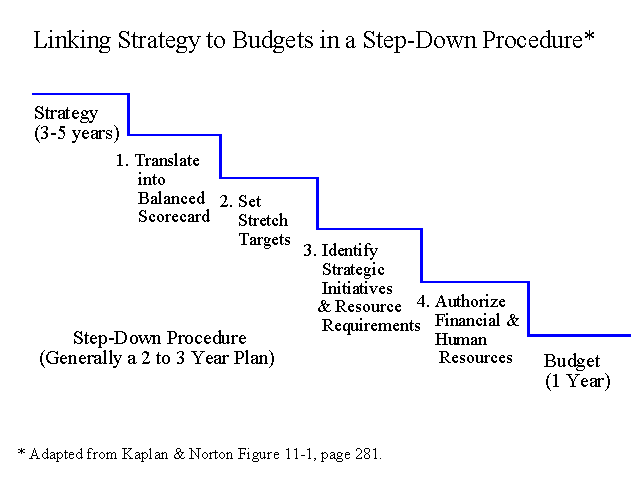
Mobil North tried to tie incentive compensation to achieving targets on the BSC. For example, a score of 1.25 would represent top competitor performance, and a 0.75 would represent well below the industry average performance. If the company achieved a score of 1.25, management would receive a 20% bonus while a 0.75 score would give them a 1% maximum bonus. As a result of tying in compensation, the meetings were a highlight to the members of the company, and their bonuses have remained between 17-19% since they began the system.
Budgets are primarily operational and strategic. The operational side forecasts the revenues expected from goods sold. It takes into consideration the current customers and products and new customers and new products. Kaplan and Norton suggest using activity-based costing because of the simplicity of understanding an ABC system. They do, however, stress that it would be extremely difficult to change costing systems because of the detail one would have to specify, such as details about production and sales. Most of the organization's spending on resources will be determined in its operational budget.
Strategic budgeting is when you identify what new operations are required and new capabilities must be created. The process allows initiatives to help the company achieve their objectives, and serve as an ends themselves. In other words, the company should not confuse completion as the target rather than improvement of effectiveness. Continuous improvement is the goal.
Chemical Retail Band had many initiatives, 70, and complained they could not possibly have room to improve at this point. They simultaneously had too many and too few initiatives. They tried to link the initiatives to the BSC, and more than 1/3 of the initiatives were irrelevant. Chemical Retail Bank retired some of the old irrelevant initiatives freeing up money and time so they could concentrate on the true initiatives while constantly improving them.
One way National Bank Online Financial Services solved this problem was by establishing a set of criteria for budgeting objectives. Their criteria provide the following advantages.
1. Helps OFS achieve a strategic objective (defined by the three strategic themes outlined in the BSC).
2. Builds a competitive advantage.
3. Builds a sustainable point of differentiation.
Budgets can be tedious work, but by using strategy focused budgets they can improve the focus on new decisions and motivate workers to comply with the new budget.
Chapter 12: Feedback and Learning
The strategy articulated on the BSC must be correct in order for the organization to succeed. Meetings also must emphasize strategy, not tactics. Meetings become more interesting because it introduces a new culture on teamwork when they incorporate BSC measures in management meetings. AT&T Canada's CEO, Bill Catucci, set up an organized theme to achieve productive meetings as illustrated in the graphic below.
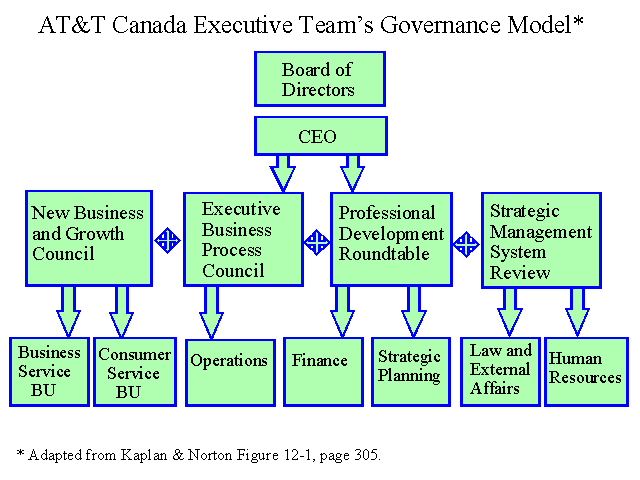
Studies also showed that employee attitudes were linked to customers. Employees had the ability to recommend products to friends, family, and other customers. The company intranets started to allow access by their employees to the BSC. Because new strategies come from within, such as Mobil's speedpass, this would be an efficient way to communicate through the organization. This also means that lots of factors in the organization must change.
Chapter 12 addresses 'Store 24', and their idea of 'Ban Boredom'. The organization quickly found out that customers would rather receive their products quicker, so they changed their theme to 'Cause You Just Can't Wait'. The BSC allowed the company to see what the problem was, and adapt and modify. The way the company handles the changes within the organization tells a lot about how the new culture will emerge. The primary focus of the BSC is to focus on processes. When the evolution of computers being able to hold large amounts of information came to be, lots of companies were reluctant, but eventually had to change their old habits. They have to focus on the way leaders integrated activities to mobilize their organizations to maintain momentum for change.
Chapter 13: Leadership and Mobilization
When there is an urgency for change in a company, a good place to start planning the change is to develop a BSC. National Bank Online Financial Services developed there SC by setting targets for example, they wanted to triple their customer base in less than 3 years. They also wanted to become the first internet bank with 1million customers and reduce cost per customer by 35%. They strived to reach these targets by strategically aligning them in the BSC.
Although it is popular for companies to ask their employees to double sales or marketing threefold, they fail to provide a means to achieve the goals. The BSC provides a road map for such a dramatic internal change.
Mobil North had a problem with seeing the benefits from their vertical integration strategy or corporate-level strategy. They weren't sure if the corporate BSC was making an impact to add value on non-financial and financial measures. Since they have three segments, exploration and production, marketing and refining, and chemicals, they decided to explicate the synergies, rational, and value of their individual strategies through the BSC.
GTE used shared service units in the HR department, and developed a BSC at human resources. They constructed a strategy to promote successful measures, such as communications in the business unit, skills, and knowledge of the product. The shared service unit in Europe was asked to encompass their strategies with 8 other business units and 11 functional units. The IT team also taught about cause-and-effect linkages to ensure the BSC related to strategy objectives, not just operational improvements.
The same words mean different things to different people, but when the statements are translated into measures that everyone understands, the vision and strategy become clear. Leadership style should focus on communication, team building, and empowerment. However, you want to focus on successful measures, not quarterly earnings, for example. That promotes short-term thinking, instead of investing in the long-run.
Chapter 14: Avoiding Pitfalls
Companies that have a program of measurement installed in their organizations typically also have better teamwork and communication. The following illustration shows that, on average, a 'balanced measurement company' seems to have more alignment than a 'non-balanced measurement company'.
| Elements of Alignment and Awareness |
Balanced Measurement Companies |
Non-Balanced Measurement Companies |
| Agreement among senior management strategy | 90% | 47% |
| Good cooperation and teamwork among management | 85% | 38% |
| Open sharing and communication | 71% | 30% |
| Effective communication of strategy | 60% | 8% |
| High levels of self-monitoring by employees | 42% | 16% |
Some companies have difficulty implementing the BSC because of transitional, design, and process issues. Transitional issues occur when the company wants to down-size or cut costs. They look at the BSC as part of the problem. They throw out the ideas the BSC offers, and try to ingrain their own ideas into the organization. Design failure is when the BSC has too many or too few measures or objectives. The measures can't be linked to the BSC, or the BSC doesn't have enough linkages. Process failure occurs when any of the following are present:
1. Lack of senior management commitment.
2. Too few individuals involved.
3. Keeping the BSC at the top.
4. Too long a development process; the BSC as a one-time measurement project.
5. Treating the BSC as a systems project.
6. Hiring inexperienced consultants.
7. Introducing the BSC only for compensation.
The BSC should be used as a tool of communication and linking strategy. It would be wise to try and avoid the pitfalls discussed in the above summary in order to reap the rewards of the BSC.
__________________________________________________
Related Summaries:
Appelbaum, D., A. Kogan, M. Vasarhelyi and Z. Yan. 2017. Impact of business analytics and enterprise systems on managerial accounting. International Journal of Accounting Information Systems (25): 29-44. (Summary).
Johnson, M. W., C. M. Christensen and H. Kagermann. 2008. Reinventing your business model. Harvard Business Review (December): 50-59. (Summary).
Kaplan, R. S. and D. P. Norton. 1992. The balanced scorecard - Measures that drive performance. Harvard Business Review (January/February): 71-79. (Summary).
Kaplan, R. S. and D. P. Norton. 1993. Putting the balanced scorecard to work. Harvard Business Review (September-October): 134-147. (Summary).
Kaplan, R. S. and D. P. Norton. 1996. The Balanced Scorecard: Translating Strategy into Action Boston: Harvard Business School Press. (Summary).
Kaplan, R. S. and D. P. Norton. 1996. Using the balanced scorecard as a strategic management system. Harvard
Business Review (January-February): 75-85. (Summary).
Kaplan, R. S. and D. P. Norton. 1997. Why does business need a
balanced scorecard? Journal of Cost Management (May/June): 5-10. (Summary).
Kaplan, R. S. and D. P. Norton. 2000. Having trouble with your strategy? Then map it. Harvard Business Review (September-October):
167-176. (Summary).
Kaplan, R. S. and D. P. Norton. 2001. Transforming the balanced scorecard from performance measurement to strategic management: Part I.
Accounting Horizons (March): 87-104. (Summary).
Kaplan, R. S. and D. P. Norton. 2001. Transforming the balanced scorecard from performance measurement to strategic
management: Part II. Accounting Horizons (June): 147-160. (Summary).
Kaplan, R. S. and D. P. Norton. 2004. Measuring the strategic readiness of intangible assets. Harvard Business Review (February): 52-63. (Summary).
Kim, W. C. and R. Mauborgne. 2004. Blue ocean strategy. Harvard Business Review (October): 76-84. (Summary).
Kim, W. C. and R. Mauborgne. 2009. How strategy shapes structure. Harvard Business Review (September): 72-80. (Summary).
Kim, W. C. and R. Mauborgne. 2015. Red ocean traps: The mental models that undermine market-creating strategies. Harvard Business Review (March): 68-73. (Summary).
Lyons, B., A. Gumbus and D. E. Bellhouse. 2003. Aligning capital investment decisions with the balanced scorecard. Journal of Cost Management (March/April): 34-38. (Summary).
Malone, D. and M. Mouritsen. 2014. Change management: Risk, transition, and strategy. Cost Management (May/June): 6-13. (Summary).
Martin, J. R. Not dated. Balanced scorecard concepts. Management And Accounting Web. BalScoreSum.htm
Martin, J. R. Not dated. Simon's levers or control in relation to the balanced scorecard. Management And Accounting Web. Simon'sLeversofControl.htm
Martinsons, M., R. Davison and D. Tse. 1999. The balanced scorecard: A foundation for the strategic management of information systems. Decision Support Systems (25): 71-88. (Summary).
Norreklit, H. 2003. The balanced scorecard: What is the score? A rhetorical analysis of the balanced scorecard. Accounting, Organizations and Society 28(6): 591-619. (Summary).
Paladino, B. 2007. 5 key principles of corporate performance management: How do Balanced Scorecard Hall of Fame, Malcolm Baldrige, Sterling, Fortune 100, APQC, and Forbes award winners drive value? Strategic Finance (June): 39-45. (Note).
Porter, M. E. 1980. Competitive Strategy: Techniques for Analyzing Industries and Competitors. The Free Press. (Summary).
Porter, M. E. 1987. From competitive advantage to corporate strategy. Harvard Business Review (May-June): 43-59. (Summary).
Porter, M. E. 1996. What is a strategy? Harvard Business Review (November-December): 61-78. (Summary).
Porter, M. E. and M. R. Kramer. 2006. Strategy and society: The link between competitive advantage and corporate social responsibility. Harvard Business Review (December): 78-92. (Summary).
Ridgway, V. F. 1956. Dysfunctional consequences of performance measurements. Administrative Science Quarterly (September): 240-247. (Summary).
Schonberger, R. J. 2008. Lean performance management (Metrics don't add up). Cost Management (January/February): 5-10. (Note: Schonberger criticizes the KPI or scorecard approach from the lean enterprise perspective. Summary).
Shenkir, W. G. and P. L. Walker. 2006. Enterprise risk management and the strategy-risk-focused organization. Cost Management (May/June): 32-38. (Summary).